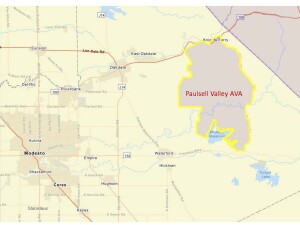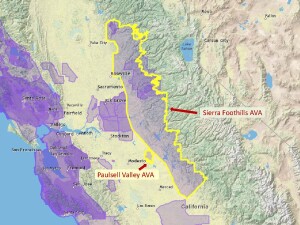On June 3 (2022) the TTB (Alcohol and Tobacco Tax and Trade Bureau) of the United States announced the approval of the Paulsell Valley American Viticultural Area (AVA), located in Stanislaus County, California.
The new AVA is located in the San Joaquin Valley (Central Valley), somewhat between the town of Knights Ferry and the Modesto Reservoir. The Paulsell Valley AVA is situated to the west of the Sierra Foothills AVA and to the south of the Lodi AVA; it does not, however, overlap with any previously established viticultural area. The name Paulsell refers to a nearby unincorporated community—sometimes known as Old Paulsell Town—and the valley that runs through it, carved by Dry Creek
- According to the original petition—originally submitted in 2018 by Patrick L. Shabram on behalf of the grape growers in the area—the distinguishing features of the Paulsell Valley AVA include its topography, soils, and climate, as described below.
- Topography: The landscape within the new AVA consists mainly of rolling hills interspersed with water-carved channels and steep, isolated hills known as intermounds. This type of landscape is known as mound-intermound relief and is unique to the area (as compared with the surrounding landscape). Elevations in the Paulsell AVA range from 140 to 612 feet asl. The numerous slopes allow for excellent drainage, while the isolated patches of higher elevation (located towards the top of the intermounds) allow for long hours of sun exposure.
- Soils: The soils of the Paulsell Valley AVA consist mainly of volcanic tuff (a sedimentary soil created via the compaction of volcanic ash and bits of igneous rock) and alluvial deposits. In some spots, the topsoil contains cobbles—small rocks typically defined as being 2.5 to 10 inches in diameter, sometimes referred to as cobblestones—remnants of significant flooding.
- Climate: The climate of the Paulsell Valley AVA is slightly warmer than the areas that surround it, and slightly drier than the area within the Sierra Foothills AVA. The (average) temperature within the new AVA is well above 4100 growing degrees days (GDD); by any accounts this is a warm, dry, inland area well-suited to the cultivation of hardy red grapes.
The Paulsell Valley AVA—covering a total area of 34,155 acres—contains three commercial vineyards and approximately 826 acres planted to vine (with more planned for the future). The leading grape varieties include Cabernet Sauvignon, Petit Verdot, and Petite Sirah.
Note: June 3 was a busy day for the TTB, which saw the approval of four new AVAs, including Paulsell Valley. The other three include Rocky Reach (WA), Upper Lake Valley (CA), and Mount Pisgah-Polk County (OR). When all four of these AVAs are brought into force—on July 5, 2022—the total number of AVAs in the United States will be 266; of these, 146 will be in California.
Welcome to the world, Paulsell Valley AVA!
References/for more information:
- Federal Register-June 3 2022-Establishment of the Paulsell Valley AVA
- Petition to Establish the Paulsell Valley AVA
- https://www.shabram.com/
Post authored by Jane A. Nickles…your blog administrator: jnickles@societyofwineeducators.org


I ran across this information by accident when searching for something else. From other information, I am minorly familiar with the name Paulsell in this area, and went there while in state last year trying to get more information about Paulsell, CA, the Paulsell Extension, and Paulsell Lateral.
Now, I am wondering how the Paulsell name came to be attached to this valley, and I am hoping you know, or can put me in contact with someone who does. Thank You.
I don’t have any information on why the name “Paulsell” came to be used in this part of the world, beyond what is available on the AVA petition (which is linked to the bottom of our article). Best of luck with your research!